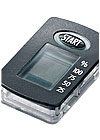
Trumeter Co. (Manchester, UK) manufactures counting, measuring and timing instruments that go into products like refrigerators and other appliances. Recently, the company decided to automate the production of an LCD counter that is used to indicate when it's time to change out the filters used in water purification systems manufactured by Brita GmbH (Taunusstein, Germany).
Historically, the company produced the counters in Thailand, where operators assembled them manually. However, because of the large number of parts and the complex nature of the assembly, the company decided to automate the process.
Ultimately, the company implemented a fully automated assembly line based on the G05 assembly system from Mikron Corp. (Boudry, Switzerland, and Aurora, CO). It did so in large part because the cell-based G05 is easily reconfigurable, which means it can be used to assembly other, newer products as market demands change.
The system that Trumeter installed consists of three G05 cells, which perform a wide range of assembly operations at 32 separate process stations. They also perform a number of checks and functional tests as part of the assembly process.
For example, the cover of the counter is joined using an ultrasonic welder and then tested to ensure it is watertight. The amount of force needed to activate each counter is also tested, as is overall counter performance.
The translation to an automated process was complicated by the fact that the counter was originally designed with manual assembly in mind. For example, each unit's LCD display is comprised of seven separate parts, with the counters coming in two different configurations. The ink-ball printing approach that Trumeter originally selected also had to be upgraded to fit in an automated environment.
Finally, Mikron engineers had to a find a way to resolve the variability of the switches' injection-molded parts with the fact that the automation process required accuracy to within a few hundredths of a millimeter. This was critical, because the counter is designed so that the user can initiate it by pressing it very lightly. This pressure, in turn, causes contact to be made with a small, internal printed circuit board via a plastic pin fitted with a small, gold contact point.
With the help of the adaptability of the G05 platform, engineers at Trumeter and Mikron were ultimately able to resolve these and all other challenges, such that the line is now producing switches more cost effectively than was the case in the past.
For more on automated assembly visit www.mikron.com.